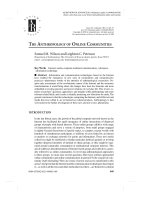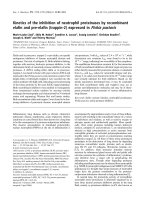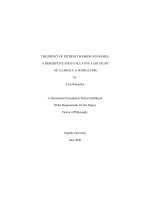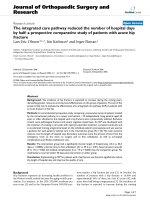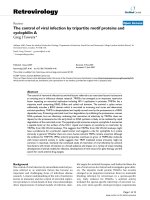The economics of sports 5th by michael a leed and allmen chapter 07
Bạn đang xem bản rút gọn của tài liệu. Xem và tải ngay bản đầy đủ của tài liệu tại đây (952.2 KB, 50 trang )
The Economics of Sports
FIFTH EDITION
Chapter 7
THE PUBLIC
FINANCE OF
SPORTS: WHO
PAYS AND WHY?
MICHAEL A. LEEDS | PETER VON ALLMEN
Introduction: The Face of Evil
• In the late 1950s, two New York reporters—
independently --choose Stalin, Hitler and Walter
O’Maley as the most despicable human beings who
ever lived
• Why O’Malley?
• He was the Brooklyn Dodgers owner
• He moved the team – in the middle of the night – to
Los Angeles
• Recall that a team can become a public good
• He realized that he had market power
• Many never forgave him
Copyright ©2014 Pearson Education, Inc. All rights reserved.
7-2
Learning Objectives
• Appreciate the connection between the mobility of
sports franchises and the increase in public funding
of stadiums and arenas
• Understand the ways that sports teams, leagues,
and institutions exercise monopoly power in their
dealings with municipalities
• Grasp the impact that exchange rates and stadium
location have on the ability of cities to retain
franchises and subsidize facilities.
• Appreciate the advantages and disadvantages of
different methods of financing public support of
sports facilities
Copyright ©2014 Pearson Education, Inc. All rights reserved.
7-3
7.1 How Cities Came to Fund
Stadiums
• Today it seems normal for teams to threaten to find
a new home unless their current host city builds a
new facility or restructures the rental agreement on
the current one
• This section provides a historical context for the
growing mobility of sports franchises and their
consequent increase in market power
Copyright ©2014 Pearson Education, Inc. All rights reserved.
7-4
Teams on the Move
• The Dodgers left Brooklyn after the 1957 season
• They were not the first team to move
– The Braves, Browns, & A’s moved earlier
– But they were all neglected stepsisters in cities
• The Braves’ move ended MLB’s “Golden Age”
–
–
–
–
–
Golden Age lasted fifty years: 1903-53
It was a period of absolute stability
No teams entered or left MLB
No teams moved
Major parks were built (Shibe, Forbes Field, Comiskey)
• Boom ends in 1923 with Yankee Stadium
Copyright ©2014 Pearson Education, Inc. All rights reserved.
7-5
The Dodgers Were Different
• The Dodgers did not have to move
– They were the most profitable MLB team in the 1950s
(1947-57)
– They accounted for 47% of the National League’s profits
– They were a “cultural totem” for Brooklynites and all
Americans
Copyright ©2014 Pearson Education, Inc. All rights reserved.
7-6
Opportunity Costs
• The Dodgers moved because they could earn even
more in LA
• Staying in Brooklyn imposed a high opportunity cost
• Accounting profit = revenue-explicit costs
• Economic profit = revenue – all costs (explicit as
well as implicit) – revenue that could have been
earned with the given resources elsewhere
• Dodgers revenue was much higher in LA (2 million
fans) than Brooklyn (1 million fans)
Copyright ©2014 Pearson Education, Inc. All rights reserved.
7-7
The Three Eras of Stadium
Construction
• Judith Grant Long identifies three phases of stadium
funding
• The “entrepreneurial period” lasted from 1890 to 1930
• The “civic infrastructure” period lasted from 1953 to
1980
• The “public-private partnership” began after 1980 and is
still ongoing
Copyright ©2014 Pearson Education, Inc. All rights reserved.
7-8
Era #1: 1890 – 1930
• All facilities are called “Park” or “Field”
– The names reflect pastoral origin of baseball
– The term stadium was not used until Jacob Ruppert applied
the name to his new “Yankee Stadium” in 1923
• All facilities bear the name of a team owner who
built the stadium to house his team
– Exception – sort of – Wrigley Field
• It was originally “Weeghman” Field built by Federal
League
• The team and stadium were later bought by Wrigley
– Public financing of facilities is an exception
Copyright ©2014 Pearson Education, Inc. All rights reserved.
7-9
Era #1: 1890 – 1930 (cont.)
• “Golden Age” kept teams in the facilities they built in the
early 20th century
• Football teams rented space in baseball parks – got their
names from them (Bears/Cubs; Lions/Tigers;
Giants/Giants)
•Most no longer exist (Wrigley; Fenway are
exceptions)
Copyright ©2014 Pearson Education, Inc. All rights reserved.
7-10
Era #2: 1953 – 1980
• Cities started to view teams and stadiums as
centerpieces of urban development
• Cities frequently bid against one another to attract
or retain teams
• Names reflect change of funding source
– Facilities are municipally built and leased to teams
– Named for city, geographic trait, or patriotic theme
• Most of these have also disappeared
Copyright ©2014 Pearson Education, Inc. All rights reserved.
7-11
Era #3: 1980 – Present
• Local and state governments have funded about
half the construction costs
• Some are completely publicly funded (FedEx Forum)
• Firms have sought new revenues
– They sell “Naming rights” to firms
• Extra
– Dallas had the first football only stadium (1971)
– Edward Jones built for the Rams in St. Louis (1995) even
though the baseball team was still there
Copyright ©2014 Pearson Education, Inc. All rights reserved.
7-12
How Teams Exploit Monopoly
Power
• The Dodgers’ move fundamentally altered the
relationship between teams and the cities that host
them
• If the highly profitable Dodgers could be uprooted,
so could any team
• Cities have bid for teams to keep them or to lure
them
• They offer better facilities to do so
• Cities have exploited their monopoly power and
used the all-or-nothing demand curve
• Cities have also fallen prey to the winner’s curse
Copyright ©2014 Pearson Education, Inc. All rights reserved.
7-13
Leagues, Cities, and Market
Power
• North American sports leagues have limited the
number of teams
• They seek to increase both competitive balance and
profits
• Before WWII, neither the LB nor NFL had any teams
on the west coast
• The Depression delayed any moves
• After WWII, both MLB and the NFL placed teams on
the West Coast, but neither sport increased the
number of teams
Copyright ©2014 Pearson Education, Inc. All rights reserved.
7-14
Westward Ho
• The NFL’s Rams left Cleveland for Los Angeles in
1946
• This was in response to the creation of the
Cleveland Browns of the new All-American Football
Conference
• MLB almost admitted the Pacific Coast League (PCL)
as a third major league
– The PCL was a high minor league where Ted Williams and
Joe DiMaggio had once played
– The deal fell through when MLB refused to honor PCL
contracts
• Instead, MLB allowed the Giants and Dodgers to
move to the West Coast
Copyright ©2014 Pearson Education, Inc. All rights reserved.
7-15
Baseball’s Expansion after 1961
• The expansion had two goals
– Appease Congress, which was angered by the move of the
Senators to Minneapolis–St. Paul (where they became the
Twins)
• Congress threatened to mull over the anti-trust
exemption
– Prevent the formation of a new league
• Branch Rickie wanted new teams in NY and Houston,
two key cities for MLB
• MBA created the Angels in LA (to help round out the
American League)
• It created new teams in NY, Houston, and DC
Copyright ©2014 Pearson Education, Inc. All rights reserved.
7-16
Football’s Expansion
• The NFL’s first expansion came in 1960
– The NFL tried to prevent the creation of American Football
League (AFL)
– The NFL put franchises in Dallas and Minneapolis to
prevent the AFL from putting teams there
• Its second expansion was also tied to AFL
– It was linked to AFL/NFL merger in 1966-67
– Limited antitrust exemption needed the support of a
Louisiana Congressman and Senator
– The New Orleans Saints were born as a result
Copyright ©2014 Pearson Education, Inc. All rights reserved.
7-17
Missteps by Cities and Leagues
• Some cities have committed to funding before seeing what the
cost would be
– This enhances the teams’ monopoly power
– Cleveland overpaid millions for Gund (now Quicken Loans)
Arena and Jacobs (now Progressive) Field in 1990 as a result
• Some feel that MLB & NHL have over-expanded
– The lack of bidders for franchises lessens their monopoly
power
– Few cities bid for the Expos when MLB sought to move
them from Montreal
• Australian Rules Football teams lack monopoly power because
of the regional appeal of their game
– 10 of the18 teams are located in or around Melbourne
Copyright ©2014 Pearson Education, Inc. All rights reserved.
7-18
The All-or-Nothing Demand
Curve
• When NASCAR sought a host city for its Hall of
Fame, it did not offer cities a choice of how much
material they wished to house
– It was the whole collection or nothing
• The all-or-nothing choice gave NASCAR an
advantage that very few monopolists ever get to
exercise
• Even the most powerful monopolist cannot tell
consumers how much to pay and how much to buy
Copyright ©2014 Pearson Education, Inc. All rights reserved.
7-19
All-or-Nothing Demand
• In a competitive market
P
D
– At Pe consumers buy Qe
– Consumers get blue surplus
• Even a monopolist is
restricted to a demand
curve: chooses Pe or Qe,
not both
Surplus
Pe
Qe
Copyright ©2014 Pearson Education, Inc. All rights reserved.
Q
7-20
Firms Can Extract Surplus
• Consumers must choose
Qm or nothing
P
D
– They cannot buy Qe
• Consumers lose red area
– To get the surplus they must
absorb the loss
– They are still better off
because the blue area is
larger than the red
Surplus
Pe
Loss
Qe
Copyright ©2014 Pearson Education, Inc. All rights reserved.
Qm
Q
7-21
How Far Can The Firm Go?
• Consumer buys Qe as
long surplus > loss
P
– Buying Qm beats buying
nothing
• The maximum Qm sets
loss equal to surplus
D
Surplus
Pe
Loss
– Area of red triangle = Area
of blue triangle
Q
e
Copyright ©2014 Pearson Education, Inc. All rights reserved.
Qm Q
7-22
Present Value
• To value facilities and mega-events today, we must
consider their future cash flow streams
– Benefits often occur over many years
– Funding also occurs over many years
• Future costs and benefits are not worth the same as
current costs and benefits
– We would rather have $1 today than $1 tomorrow
– We must discount future costs and benefits
• Assume a stadium brings benefits over T years
– Each year’s benefits are given by Bt
– The total value of the stadium is less than B 1 + B2
+ B3 + … + B T
Copyright ©2014 Pearson Education, Inc. All rights reserved.
7-23
The Arithmetic of Discounting
• If the interest rate is r
– Having $1 today can bring $1*(1+r) in one year
• The future value of $1 in one year is $1*(1+r)
– This means that having B1 in one year is like having B1/
(1+r) now
• B1/(1+r) is the present value of B1
• By extension, having B2 in two years is like having
B2/(1+r) in one year
• Or [B2/(1+r)]/(1+r) = B2/[(1+r)2] today
• B2/(1+r)2 is the present value of B2
• The value of the stream of benefits is thus:
B1/(1+r) + B2/(1+r)2 + B3 /(1+r)3 + …BT/(1+r)T
Copyright ©2014 Pearson Education, Inc. All rights reserved.
7-24
Contingent Valuation (CV)
• CV surveys ask residents what they would be willing to
pay to attract or retain a franchise
• There are three types of CV surveys
– Open-ended: “What would you be willing to pay?”
– Bracketed: “Which of the following would you be
willing to pay?”
– Closed-ended: “Would you be willing to pay $X?”
• Drawbacks of CV surveys
– They are non-binding so there is no penalty for giving
a large answer
– Some believe that respondents undervalue the
burden of a stream of future payments so the answer
varies with the payment method
Copyright ©2014 Pearson Education, Inc. All rights reserved.
7-25
